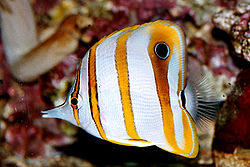| Copperband butterflyfish | |
|---|---|
 | |
| Scientific classification | |
| Kingdom: | Animalia |
| Phylum: | Chordata |
| Class: | Actinopterygii |
| Order: | Acanthuriformes |
| Family: | Chaetodontidae |
| Genus: | Chelmon |
| Species: | C. rostratus |
| Binomial name | |
| Chelmon rostratus | |
| Synonyms [2] | |
| |
The copperband butterflyfish (Chelmon rostratus), also known as the beaked coral fish, is found in reefs in both the Pacific and Indian Oceans. This butterflyfish is one of the three species that make up the genus Chelmon and all have long beaks.



